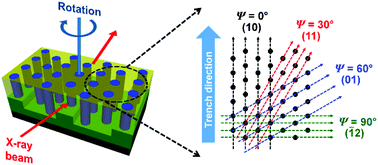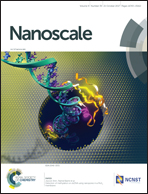Macroscopically ordered hexagonal arrays by directed self-assembly of block copolymers with minimal topographic patterns†
Abstract
A simple and robust method has been developed for the generation of macroscopically ordered hexagonal arrays from the directed self-assembly (DSA) of cylinder-forming block copolymers (BCPs) based on minimal trench patterns with solvent vapor annealing. The use of minimal trench patterns allows us to probe the guided hexagonal arrays of cylindrical microdomains using grazing incidence small angle X-ray scattering (GISAXS), where the sample stage is rotated on the basis of the six-fold symmetry of a hexagonal system. It is found that the (10) planes of hexagonal arrays of cylindrical microdomains are oriented parallel to the underlying trench direction over macroscopic length scales (∼1 × 1 cm2). However, there are misorientations of the hexagonal arrays with short-range ordering. GISAXS patterns show that the hexagonal arrays on the minimal trench pattern are distorted, deviating from a perfect hexagonal lattice. This distortion has been attributed to the absence of topographic constraints in the unconfined direction on the 1-D minimal trench pattern. Also, the frustration of BCP microdomains, arising from the incommensurability between the trench pitch and natural period of the BCP at the base of the trench, influences the distortion of the hexagonal arrays.



 Please wait while we load your content...
Please wait while we load your content...